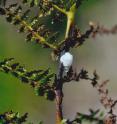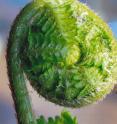Peculiar parasitoid wasp found on rare sawfly developing in ferns
A mysterious parasitoid wasp was found in the Böhmerwald (Northeast Austria) and reared in the garden of the amateur entomologist Ewald Altenhofer of Gross Gerungs municipality, Austria. The parasitoid was identified by Kees van Achterberg, senior researcher at the Naturalis Biodiversity Center in Leiden, the Netherlands, as the rare Seleucus cuneiformis. It is the first time that a tip of its biology was discovered. The study was published in the open access journal Journal of Hymenoptera Research.
The parasitoids reared by Mr Altenhofer belong to the peculiar genus Seleucus. The reared parasitoid Seleucus cuneiformis is known from only a few countries in Europe and is new to Austria. The host is the fern sawfly Blasticotoma filiceti, the only member of the family Blasticotomidae in Europe. The family is considered to be one of the oldest extant families of the true sawflies. This particular sawfly was previously known only from the region near Linz since 1973 and this is the second find reported for the fauna of Austria.
The larvae of B. filiceti live in the stems of ferns in a small chamber, or gall, that they induce themselves for their protection. They feed on the nutrients in the phloem fluids and may produce foam on the outer side of the gall. The larvae have a true ant trophobiosis, or ants can live in symbiosis based on food for protection, the only known occurrence of this phenomenon within the Hymenoptera. The Myrmica ants receive fluids through some holes connected to the stem gall of the larva.
During the rearing experiments, important notes on the previously unknown biology of the parasitoid wasp were recorded. Four weeks after the sawflies emerged from the gall, the adults of Seleucus cuneiformis also started appearing, which continued over a period of two weeks. Interestingly, the parasitoid females at first had a droplet-shaped rear body characteristic for males. During the course of the first day the metasoma got expanded into the very elongate shape typical of females, which is of use to inject their eggs into the galls of the sawflies.
Source: Pensoft Publishers
Other sources
- Peculiar parasitoid wasp found on rare sawfly developing in fernsfrom Science DailyMon, 25 Mar 2013, 19:00:39 UTC
- Peculiar parasitoid wasp found on rare sawfly developing in fernsfrom PhysorgMon, 25 Mar 2013, 16:30:54 UTC


